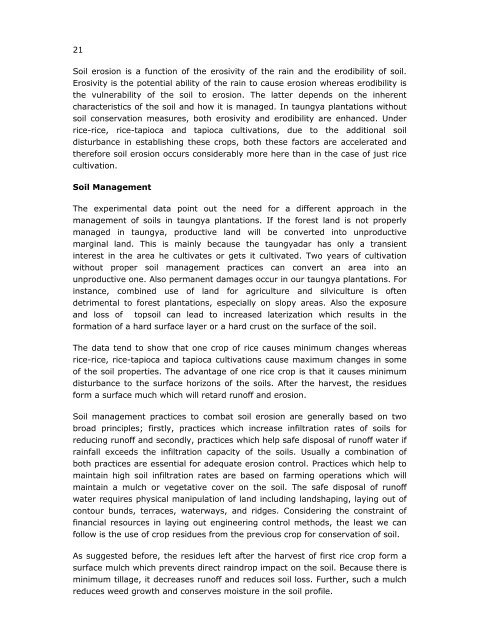taungya in relation to soil properties soil erosion and soil management
taungya in relation to soil properties soil erosion and soil management
taungya in relation to soil properties soil erosion and soil management
Create successful ePaper yourself
Turn your PDF publications into a flip-book with our unique Google optimized e-Paper software.
21Soil <strong>erosion</strong> is a function of the erosivity of the ra<strong>in</strong> <strong>and</strong> the erodibility of <strong>soil</strong>.Erosivity is the potential ability of the ra<strong>in</strong> <strong>to</strong> cause <strong>erosion</strong> whereas erodibility isthe vulnerability of the <strong>soil</strong> <strong>to</strong> <strong>erosion</strong>. The latter depends on the <strong>in</strong>herentcharacteristics of the <strong>soil</strong> <strong>and</strong> how it is managed. In <strong>taungya</strong> plantations without<strong>soil</strong> conservation measures, both erosivity <strong>and</strong> erodibility are enhanced. Underrice-rice, rice-tapioca <strong>and</strong> tapioca cultivations, due <strong>to</strong> the additional <strong>soil</strong>disturbance <strong>in</strong> establish<strong>in</strong>g these crops, both these fac<strong>to</strong>rs are accelerated <strong>and</strong>therefore <strong>soil</strong> <strong>erosion</strong> occurs considerably more here than <strong>in</strong> the case of just ricecultivation.Soil ManagementThe experimental data po<strong>in</strong>t out the need for a different approach <strong>in</strong> the<strong>management</strong> of <strong>soil</strong>s <strong>in</strong> <strong>taungya</strong> plantations. If the forest l<strong>and</strong> is not properlymanaged <strong>in</strong> <strong>taungya</strong>, productive l<strong>and</strong> will be converted <strong>in</strong><strong>to</strong> unproductivemarg<strong>in</strong>al l<strong>and</strong>. This is ma<strong>in</strong>ly because the <strong>taungya</strong>dar has only a transient<strong>in</strong>terest <strong>in</strong> the area he cultivates or gets it cultivated. Two years of cultivationwithout proper <strong>soil</strong> <strong>management</strong> practices can convert an area <strong>in</strong><strong>to</strong> anunproductive one. Also permanent damages occur <strong>in</strong> our <strong>taungya</strong> plantations. For<strong>in</strong>stance, comb<strong>in</strong>ed use of l<strong>and</strong> for agriculture <strong>and</strong> silviculture is oftendetrimental <strong>to</strong> forest plantations, especially on slopy areas. Also the exposure<strong>and</strong> loss of <strong>to</strong>p<strong>soil</strong> can lead <strong>to</strong> <strong>in</strong>creased laterization which results <strong>in</strong> theformation of a hard surface layer or a hard crust on the surface of the <strong>soil</strong>.The data tend <strong>to</strong> show that one crop of rice causes m<strong>in</strong>imum changes whereasrice-rice, rice-tapioca <strong>and</strong> tapioca cultivations cause maximum changes <strong>in</strong> someof the <strong>soil</strong> <strong>properties</strong>. The advantage of one rice crop is that it causes m<strong>in</strong>imumdisturbance <strong>to</strong> the surface horizons of the <strong>soil</strong>s. After the harvest, the residuesform a surface much which will retard runoff <strong>and</strong> <strong>erosion</strong>.Soil <strong>management</strong> practices <strong>to</strong> combat <strong>soil</strong> <strong>erosion</strong> are generally based on twobroad pr<strong>in</strong>ciples; firstly, practices which <strong>in</strong>crease <strong>in</strong>filtration rates of <strong>soil</strong>s forreduc<strong>in</strong>g runoff <strong>and</strong> secondly, practices which help safe disposal of runoff water ifra<strong>in</strong>fall exceeds the <strong>in</strong>filtration capacity of the <strong>soil</strong>s. Usually a comb<strong>in</strong>ation ofboth practices are essential for adequate <strong>erosion</strong> control. Practices which help <strong>to</strong>ma<strong>in</strong>ta<strong>in</strong> high <strong>soil</strong> <strong>in</strong>filtration rates are based on farm<strong>in</strong>g operations which willma<strong>in</strong>ta<strong>in</strong> a mulch or vegetative cover on the <strong>soil</strong>. The safe disposal of runoffwater requires physical manipulation of l<strong>and</strong> <strong>in</strong>clud<strong>in</strong>g l<strong>and</strong>shap<strong>in</strong>g, lay<strong>in</strong>g out ofcon<strong>to</strong>ur bunds, terraces, waterways, <strong>and</strong> ridges. Consider<strong>in</strong>g the constra<strong>in</strong>t off<strong>in</strong>ancial resources <strong>in</strong> lay<strong>in</strong>g out eng<strong>in</strong>eer<strong>in</strong>g control methods, the least we canfollow is the use of crop residues from the previous crop for conservation of <strong>soil</strong>.As suggested before, the residues left after the harvest of first rice crop form asurface mulch which prevents direct ra<strong>in</strong>drop impact on the <strong>soil</strong>. Because there ism<strong>in</strong>imum tillage, it decreases runoff <strong>and</strong> reduces <strong>soil</strong> loss. Further, such a mulchreduces weed growth <strong>and</strong> conserves moisture <strong>in</strong> the <strong>soil</strong> profile.

















